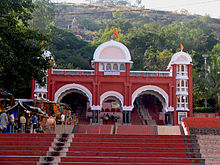Population[edit]
| [show]Pune population[54] |
|---|
The population of the Pune city is 3,124,458 and Pune Urban Agglomeration (Pune Metropolitan Area) is 5,057,709 as of 2011 census.[55] The same was about 4,485,000 in 2005. The migrating population rose from 43,900 in 2001 to 88,200 in 2005.[56] The estimated population in 2016 for the Pune metro region is 6,226,959.[54] According to the Pune Municipal Corporation, 40% of the population lived in slums in 2001.[57] The sharp increase in censorial decade of 1991–2001 can be attributed to the absorption of 38 fringe villages into the city.[58] The average literacy rate of Pune was 86.15 in 2011 compared to 80.45 in 2001.[59][60] Marathi is the official and most widely spoken language, while English and Hindi are understood and spoken. Pune has a great Marathi influence, because it was the bastion of the Maratha Empire
Religion[edit]
Hinduism is the dominant religion in Pune. Many Churches, Mosque, Gurudwaras, Buddhist Viharas, Jewish synagogues, Jain temples, and other religious buildings are found throughout the city.[61] Major communities by religion include Hindus, Muslims, Sikhs, Jains, Buddhists, and Christians. The most prominent Hindu temple in Pune is the Parvati Temple, located on Parvati hill and visible from most of the inner suburbs. The most visited temple is likely the Dagadusheth Halwai Ganapati temple, located in old city area of Pune. Also a popular temple is the Chaturshrungi Temple, located on Senapati Bapat road in the north west area of Pune. During Navratri, there is a large fair at the temple and worshippers gather from around the country to pray here. The presiding Deity of the city is the Kasba Ganapati this temple has be first redeveloped by Rajmata Jijau, whose temple is located in Kasba Peth in central Pune. Sarasbaug Ganpati is also a prominent landmark in Pune.
Islam is the second largest religion in Pune.[62] Pune has a large number of Mosques, the most prominent of which are Chand Tara Masjid, Jaama Masjid, and Azam Campus Masjid. Chand Tara Masjid, located in Nana Peth, is one of the biggest and most important mosques in Pune as it is the city headquarters (markaz) for the Tablighi Jamaat. The Eid-gah Maidan located near Golibar Maidan on Shankar Sheth Road witnesses a large gathering of people for Eid namaz on Eid al-Fitr and Eid al-Adha.
Pune has over 20 Gurdwaras. Gurdwara Guru Nanak Darbar,Camp and Gurdwara Shri Guru Singh Sabha, Ganesh Peth being the ones situated in the heart of the city. Sikhism is one of the major religions of Pune and Sikhs have become an integral part of the society. The former mayor of Pune too was a Sikh. The community also runs 2 schools.The Sikh community in Pune celebrates Gurpurabs with a lot of enthusiasm. They also organise Kirtan Darbars yearly which are attended by many important religious figures of the Sikh community as well as other communities. They serve Langar to all irrespective of the caste, creed or race of a person.
Other important religious places of other religions in Pune are the Ohel David Synagogue, The St Peter's Cathedral, Dapodi Church, JJ Agiary.
The Shrutisagar Ashram, located at Phulgaon off the Nagar road, houses the Vedanta Research Centre and a unique temple of Dakshinamurthy, located near the confluence of the Bhima, Bhama, and Indrayani rivers. It was established in 1989 by Swami Swaroopanand Saraswati. Here one can find detailed explanations ofśruti and smriti (including the Vedas, Bhagavad Gita, Upanishads and Puranas) in Marathi and English. As of the 2011 census, the population of Pune is as follows.[63]
| Religion | Total | Percentage |
|---|---|---|
| Hindu | 2,481,627 | 79.43% |
| Muslims | 344,571 | 11.03% |
| Buddhist | 123,179 | 3.94% |
| Jain | 76,441 | 2.45% |
| Christian | 67,808 | 2.17% |
| Sikh | 13,558 | 0.43% |
| Not Stated | 10,906 | 0.35% |
| Others | 6,368 | 0.20% |
Spirituality[edit]

Pune has been associated with several significant spiritual teachers. Osho lived and taught in Pune for much of the 1970s and 1980s. The Osho International Meditation Resort, one of the world's largest spiritual centres, is located in the Koregaon Park area. It has visitors from over a hundred countries. Pune is also the birthplace of Meher Baba, although his followers usually travel to Meherabad to visit his tomb. Hazrat Babajan, identified by Meher Baba as one of the five Perfect Masters, lived the final 25 years of her life in Pune. She was an Afghan Muslim noted for her great age and outdoor existence. She established her final residence first under an Azadirachta indica tree near Bukhari Shah's mosque in Rasta Peth and later under another A. indica tree in the then-dilapidated section of Pune called Char Bawdi, where she remained for the rest of her life. There is a shrine erected in her honour in Pune, around the tree under which she made her final home.[64][better source needed]
Pune is also home to the temples of some other saints who had a large inter-religious following. The Jangli Maharaj Mandir is the final resting place of Jangli Maharaj. The Mali Maharaj Mandir in Somwar Peth is a very important place of worship of the Nath Pai Sect of Hinduism. The Ramkrishna Mission Ashram at the start of Sinhgad Road is famous for its teachings of Vedanta. The ISKCON temple in the Camp area and the Hare Rama Hare Krishna Mission in the Model Colony Area.
There is a significant Sikh population in Pune. There are a number of Gurudwaras (Sikh Temples) for Sikhs. Gurudwaras in Camp, Kharki, Aundh, Pimpri, Akrudi, and Budhwar Peth are the prominent ones. The Camp Gurudwara is one of the main gurudwaras, with hundreds of people visiting it every day. It is named as "Guru Nanak Darbar" and some people also call it "Hollywood Gurudwara". This complex includes a charitable hospital, community kitchen for Langar and Sarai forrefugees.[65]




